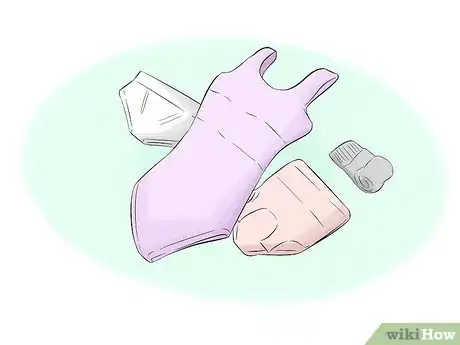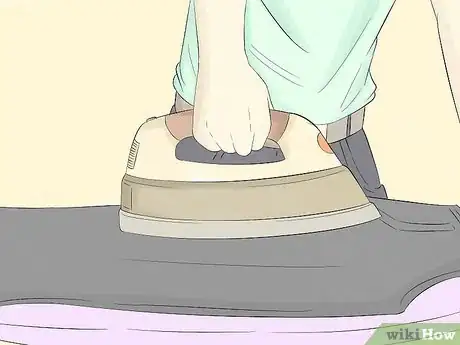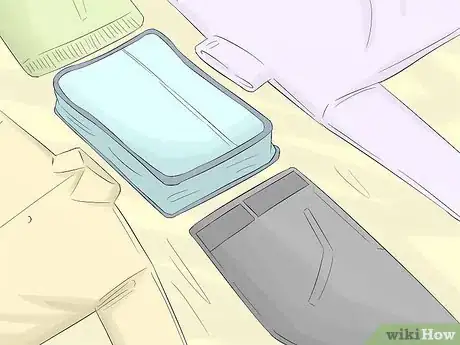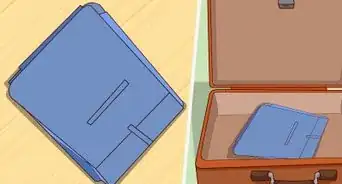X
wikiHow is a “wiki,” similar to Wikipedia, which means that many of our articles are co-written by multiple authors. To create this article, volunteer authors worked to edit and improve it over time.
This article has been viewed 20,330 times.
Learn more...
The next time you need to pack formal clothes or other garments that wrinkle easily, consider using the bundling method. By wrapping your clothes into a tight bundle instead of loosely folding or rolling them, you can eliminate most wrinkles and creases.
Steps
Part 1
Part 1 of 3:
Part One: Preparing Your Clothes
-
1Understand the concept. Bundling is a packing method used to greatly reduce wrinkles and creases. You'll wrap each garment around a core object, creating a snug bundle in the process.[1]
- Since this method requires you to wrap your clothes, you won't actually do any folding. The lack of folding results in a lack of creases.
- Wrapping items of clothing around a core and around each other also creates tension. This tension minimizes wrinkling.
-
2Prepare an organizer pouch. Find an organizer pouch with surface dimensions that are approximately 11 inches by 16 inches (30 cm by 40 cm).
- The best dimensions can vary slightly depending on how many clothes you plan to pack and how wide your suitcase is. This size works well for most circumstances, though.
- You can technically use any small object with fixed dimensions like these. Since you can fill the pouch with other necessities, however, it is typically your best option.
Advertisement -
3Fill the pouch with small, soft items. Roll or fold the socks and undergarments you plan to pack and carefully arrange them inside the pouch.
- Similar items, like swimsuits, can also be packed in your pouch.
- Place soft items in this pouch, and fill the pouch with enough of these items to create a firm pillow. The idea is to make a firm core, but it should not be a rigid one.
- Do not put anything in your pouch that you need quick access to.
-
4Iron your clothes. Take the time to iron out any major creases or wrinkles before you pack any of your garments. Correct bundling should prevent additional wrinkles from forming, but it will not remove any wrinkles currently in your clothes.
-
5Fasten all buttons, zippers, and snaps. Secure all fasteners on all garments. Button your shirts and jackets, zipper any trousers or skirts, and snap up any pockets.
- Closed surfaces will be easier to wrap than wide, open surfaces.
-
6Work on a flat surface. Clear your bed or a large area on a table or floor. It will be easiest to create your bundle in a flat spot with little clutter.
- Another option is to open your suitcase wrap the bundle directly inside. Doing so is more difficult and not ideal, but it can work in situations where wide space is not an option.
-
7Determine a working order. Large wrinkle-prone garments will need to be placed on the outside of the bundle, while smaller wrinkle-resistant garments are placed closer to the core.
- Clothing near the outer layers of your bundle will be wrapped at a gentler curve, so the risk of creasing and wrinkling is reduced even more significantly there.
- The exact arrangement will vary based on the clothes you have, but the outer layer usually consists of suit jackets and other jackets, followed immediately by long skirts and dresses. Long-sleeved shirts are next, followed by short-sleeved shirts, trousers, jeans, sweaters, and knit fabrics, in that order. Shorts and cotton pajamas are usually closest to the core.
Advertisement
Part 2
Part 2 of 3:
Part Two: Creating the Bundle
-
1Spread out the most wrinkle-prone garment. Usually, this will be a jacket, long skirt, or long dress. Lay it out flat and smooth out any folds and light wrinkles with your hands.
- Most clothes should be placed face up.
- Tailored jackets, however, should be placed face down. Arrange the sleeves so that they lie naturally.
-
2Note the dimensions of your core. One edge of each clothing item will need to line up with one edge of your core organizer.
- The direction of each consecutive layer will vary, but as you place each layer down, one edge of all existing layers (including the newest one) will need to be able to line up with one edge of the core.
- Each garment will line up with a different edge of the core, however. The garments do not need to line up with the same edge.
-
3Orient shirts vertically. Long-sleeve shirts and short-sleeve shirts are usually next in your bundle. These items should be placed vertically in your pile.
- Alternate the direction of your shirts to maintain an even shape. If the first shirt is upright, the second shirt must be upside-down, the third must be upright, the fourth must be upside-down, and so on.
- The collar edges should be aligned to the top and bottom of the core. Even though the core has not been placed down yet, keep that in mind as you position the shirts.
-
4Spread out pants horizontally. Trousers, jeans, and other pants are usually placed on top of the shirt layers and further in toward the center of the bundle. All pants should be oriented horizontally.
- Alternate the direction of your pants, too. If the waist is to the left on your first pair, the waist of your second pair should be to the right. That of the third pair should be to the left, that of the fourth should be to the right, and so on.
- The waist edges of each pair of pants should be aligned to the anticipated right and left edges of your core organizer.
-
5Repeat down to the last garment. Gradually layer the rest of your clothes on top of the others, working from the most wrinkle-prone to the most wrinkle-resistant.
- As a general rule, shorter items are oriented vertically while longer items are oriented horizontally.
- Note that wide skirts may need to be folded lengthwise before you wrap them, but you should avoid folds as often as possible.
- Smooth out each garment with your hands before spreading a new layer on top.
-
6Place the core on top. Position your organizer pouch (or other core object) on top of your assembled pile of clothing.
- Remember that one edge of your core must align with one edge of each garment.
-
7Wrap the top piece over the core. The last garment you placed should be the one closest to your core object. Wrap the three hanging sides over the edges of the core.
- The entire clothing item must be wrapped around the core. Do not leave any excess material hanging off the sides.
- Wrap the item firmly so that the fabric remains taut, but do not stretch the garment out of shape.
-
8Work your way through the rest of the pile. Wrap each consecutive garment around the core, leaving no excess material hanging off the sides of your bundle. Work with one garment at a time, continuing through the final outer piece.[2]
- If necessary, rearrange the position of the bundle so that it lines up with the correct edge of the garment layer you are currently working with.
- When working with pants, long skirts, and other long items that run from side to side, wrap the material completely over and under the bundle as much as needed to keep all of the material contained.
- When working with a long-sleeved shirt, wrap one sleeve straight across the bundle as far as possible, wrapping it across and underneath the bundle itself. Repeat that for the other sleeve, then wrap over the bottom of the garment as far as possible.
- Jacket sleeves will need to be wrapped diagonally across to keep to the natural positioning of the sleeve. As a result, they will form an "X" over the top of the bundle.
Advertisement
Part 3
Part 3 of 3:
Part Three: Carrying the Bundle
-
1Place the bundle in your bag. Carefully pick up your bundle and place it in your suitcase.
- Place the "seam" side of your bundle face down. In other words, the top-most loose edge of your bundle should face the inside of your suitcase.
- Move the bundle carefully to prevent it from unraveling. If you wound it correctly, though, the bundle should be snug enough to resist unraveling.
-
2Hold it in place. Use the interior straps of your suitcase to tie the bundle down.
- If the bundle remains loose inside the suitcase, it can move around and may start coming undone.
- The straps should be snug and secure over your bundle, but do not adjust them so tightly that they begin digging into the clothes. Excessively tight straps can cause wrinkles to form in your outer bundle layers.
- If your suitcase does not have straps, consider sewing some inside before using it. Alternatively, you can fill the sides of your suitcase with other objects to prevent the bundle from shifting as you carry the bag. This may include shoes and toiletries, among other items.
-
3Open the bundle before wearing the clothes. When you arrive at your destination, you should open the bundle and shake out the clothes to remove any light wrinkles that may have formed.
- Unwrap your bundle carefully. Start with the outermost garment and work layer by layer until you reach the garment nearest the core.
- Ideally, you should hang each unpacked item of clothing after removing it from your bundle.
- It is easiest to unwrap and hang up the entire bundle at once, but you can remove individual garments from your bundle one at a time, if desired. Simply unwrap the bundle until you reach the garment you want and remove that layer. Then, re-wrap the outer layers around the remaining bundle in their previous order and tuck the bundle away again.
Advertisement
Things You'll Need
- Organizer pouch, 11 inches by 16 inches (30 cm by 40 cm)
- Socks, undergarments, and similar objects (for the pouch)
- Pants, shirts, dresses, etc. (for the bundle)
- Iron
- Ironing board
- Flat surface
- Suitcase
- Shoes, toiletries, and other stiff objects (for the suitcase sides)
- Hangers
References
About This Article
Advertisement









































































